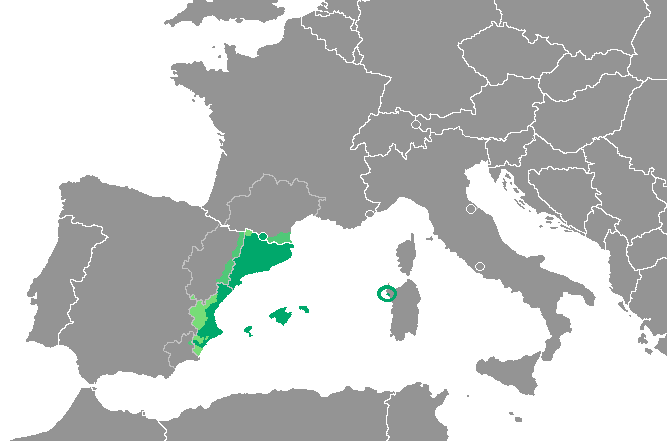Research
Current Projects
Catalan Wug Test

Regions where Catalan is spoken
Collaborators: Victoria Mateu and Bruce Hayes
Catalan phonology includes numerous consonant alternations found at the right edge of stems, such as [san-ə] ~ [sa] ‘healthy-fem./masc’. These alternations have been subjected to extensive analysis and have been frequently used as the basis of problem sets and computational studies. They bear on several important research questions including exceptionality, opacity, and saltation. However, no study has yet investigated the extent to which speakers actually generalize the patterns attested in the lexicon. Our study addresses this gap with two "wug test" experiments, one using elicited production, the other using acceptability judgments.
This work was presented as a talk at the Annual Meeting on Phonology (AMP) in November 2024 at Rutgers University in New Brunswick, New Jersey.
The manuscript is still in progress. However, you can view the handout presented at AMP here.
Phonotactics and Morpheme Discovery

A baby participating in an experiment in the UCLA Language Lab
Collaborator: Megha Sundara
By 6-months, English-learning infants are able to relate novel words suffixed with -s like babs and teeps that are embedded in passages, with just the stem bab and teep, demonstrating an early sensitivity to morphological relatedness. At the same time, infants are also becoming sensitive to phonotactics. In Experiment 1, we found that 6-month-old English-learning infants relate nonce forms suffixed with the [z] allomorph, which would be phonotactically ill-formed without a morpheme boundary, but not the [s] allomorph of the English -s suffix. In Experiment 2, we found that 6-month-olds only related nonce forms suffixed with [z] when the resulting stem would be phonotactically legal but not when it would be phonotactically illegal. These results show that morpheme decomposition is not obligatory at 6-months; instead, infants’ ability to decompose potentially suffixed words is constrained by their developing knowledge of phonotactic restrictions in English.
This work was presented as a talk at the Conference on Laboratory Phonology (LabPhon) in June 2024 at Hanyang University in Seoul, South Korea, the International Congress of Infant Studies (ICIS) in July 2024 in Glasgow, UK, and the Boston University Conference on Language Development (BUCLD) in November 2024 at Boson University in Boston, Massachusetts.
The manuscript is still in progress. However, you can read my MA thesis here which was based on an earlier version of this work.
Previous Projects
Syntactic Category Acquisition

Child-directed speech from the Manchester Corpus
Collaborator: Charles Yang
An important task faced by children during language acquisition is the formation of syntactic categories from individual words. Distributional cues such as frequent frames have been proposed but their utility under realistic learning situations remain unclear. Since frequent frames are lexical, they result in a proliferation of word classes that do not correspond to recognized syntactic categories. Thus, we propose the Category Frame Learner (CFL) model which uses the Tolerance Principle, a mathematically precise method of language learning, to combine lexical frames into category frames defined over syntactic categories.
This work was presented at a poster session of the Boston University Conference on Language Development (BUCLD) in November 2021 and as a talk at the Linguistics Society of America Annual Meeting in January 2022. You can view the BUCLD video overview here and the poster here.
This project appeared in the proceedings of the BUCLD and can be accessed here.